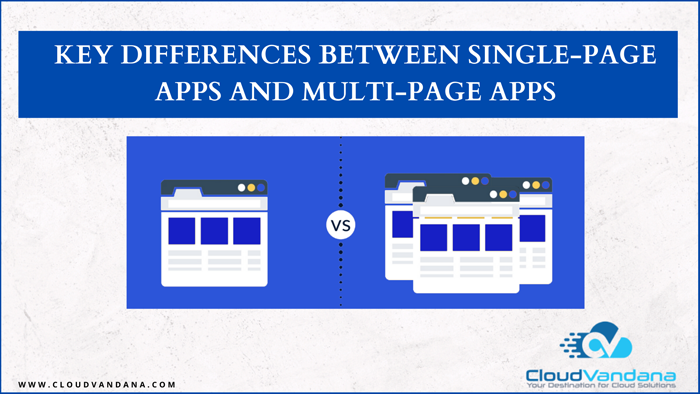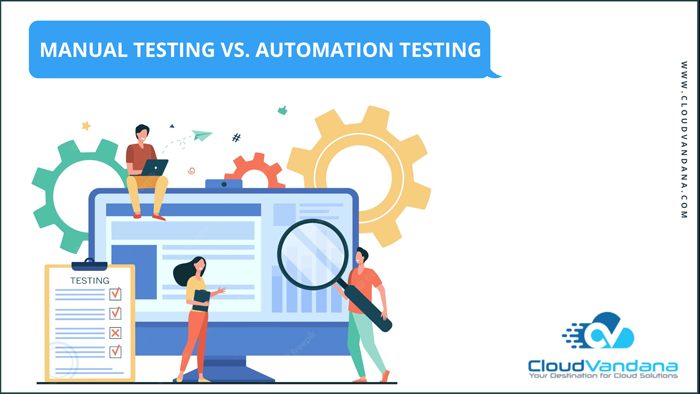KEY DIFFERENCES BETWEEN SINGLE-PAGE APPS AND MULTI-PAGE APPS

Single-page apps and multi-page apps are two methods for developing web apps. Opinions vary, but both ways are effective for web development. So, today, in this blog, CloudVandana will provide a detailed guide on the critical differences between single-page and multi-page apps. Table of Contents Single-Page Applications Advantages And Disadvantages Of Single-Page Apps Advantages 1. Easier Set up 2. Saved Bandwidth Disadvantages 1. Search Engine Optimization 2. Performance Issues Multi-Page Application Advantages And Disadvantages Of Multi-Page Apps Advantages 1. Scalability 2. Easier Optimization with search engines Disadvantages of Multi-Page Apps Disadvantages 1. Slow Performance 2. Lack Of Flexibility YOU MIGHT ALSO LIKE Single-Page Applications A single-page web application relies on client-side rendering instead of loading resources from the server. Thus, single-page apps are easy to build and maintain. They are also made, maintained, and scaled differently from the traditional web application development model. Advantages And Disadvantages Of Single-Page Apps Among various advantages, we are stating two essential advantages and disadvantages here. Advantages 1. Easier Set up A development team can select the much easier way of setting up and debugging the application in the browser in this application. A SPA consists of single CSS, HTML, and JavaScript bundles, and after the loading, the apps get ready for use. The development team then installs and configures a web server to host the app, and then the team can access it. It is favorable to software developers and potential clients. 2. Saved Bandwidth Single-page applications (SPAs) connect to the server in small batches with simpler operations. SPAs request JSON data to update one needed property on the user’s screen, freeing up bandwidth and reducing network traffic overall. Disadvantages 1. Search Engine Optimization One of the critical challenges of this application is the difficulty of optimizing a web application for search engines. The links are generally hard to get indexed, so SEO with this application is quite complicated. 2. Performance Issues The philosophy behind single-page applications suggests that when users’ experience with the website is enhanced, they feel comfortable interacting. Though SPA is fast, there are still some speed and performance issues. Besides, SPAs require more significant effort and coding knowledge to create. So, they are difficult to maintain and find coding errors. Great examples of some of the single-page applications are Google web services, Trello, Twitter, etc. Multi-Page Application A multi-page application is a traditional web page application that consists of several pages and reloads the whole page every time a user forms a new request. Multi-page applications are perfect for content and feature-rich web applications with complex service offerings that need to be further scaled over time. Multi-page applications include LAMP, MEAN, and .NET for the backend and HTML/CSS, JavaScript, TypeScript, JavaScript frameworks, package managers, Ajax, and RxJS for the front end. Advantages And Disadvantages Of Multi-Page Apps Multi-page applications have been on the market longer than single-page apps. So, let’s first examine the advantages. Advantages 1. Scalability Multi-page apps (MPAs) allow the creation of as many pages as the site needs. With this architecture, the HTML DOM has a nearly unlimited capacity without any restrictions. On the other hand, most MPAs are built as a dynamically scaling system that needs to deal with a lot of services and products. 2. Easier Optimization with search engines These applications are easily optimized with search engines like Google. Search engines can easily crawl these pages without any extra effort from the developers. As multi-page apps can be optimized, they could quickly appear in the search results. Disadvantages of Multi-Page Apps Besides many benefits, there are a few flaws in the apps. The following are two key disadvantages of this application. Disadvantages 1. Slow Performance MPA performance requires more effort to optimize. As a result, most companies select multi-page applications as they need to deal with lots of data and content and offer various services and products. However, narrow businesses that do not process much content are recommended to go for single-page applications. 2. Lack Of Flexibility Single-page apps are well known for their flexible UI feature. On the other hand, multi-page apps cannot have too many complicated mechanisms to adapt the interface according to each page’s content and each user’s device. So, the interface of a multi-page application will not be as flexible as that of a single-page application. In addition, traditional MPA contains more UI levels, which limits the ability to adapt the interface. So, from the discussion, we can say that both applications are practical, but proper expertise is needed to use them wisely. Are you running short of time and resources to hire an expert team of in-house developers? CloudVandana has a vast talent pool of talented remote developers from which organizations can select the best-suited team for their organization. Call us today and get the best software developers on demand. Call Now. Schedule A Call With Us Request a Free Consultation YOU MIGHT ALSO LIKE
WHY INDIA IS CONSIDERED THE LARGEST NODEJS TALENT HUB

NodeJs is a backend JavaScript runtime environment. It is used for traditional websites and back-end API services. While working on a server-side JavaScript project, a specialization in Node.Js is required. So expert NodeJs developers are very much needed in most of the projects. The expert developers within the team enhance the business to build dynamic and secure web applications. Today, in this blog, CloudVandana will discuss why India is considered the largest Node.Js talent hub. At the present time, Node.Js has gained popularity as a highly functional and pervasive solution in the IT industry. The technology has revolutionized the real-time application work with its faster speed, scalability, and usability features. High-end companies have implemented Node.Js in their ecosystem for their brand and revenue enhancements. Why India Is Considered The Largest NodeJs Talent Hub Offshore developers are now considered the essential assets of an organization. So businesses across the world are planning to build their team in offshore countries to hire the best team of remote developers. Over the years, Indian developers are delivering high-quality software development around the world. Let’s have a look at the benefits of hiring offshore developers from India. 1. One Stop Solution for NodeJs Indian developers are experts in handling various tasks regarding Node.Js like data streaming, high-speed web app accessing, controlling sync issues, etc to provide unlimited satisfaction to their clients. 2. Huge Talent Pool Of Skilled Developers A huge number of Indian developers are becoming part of the workforce every day. They are hardworking, dedicated, talented, and excellent in communication. They approach the work by studying each and every facet related to many technological advancements and easily get hold of high-end technology like Node.js thereby giving the best of their services to clients. Being a large talent pool, it becomes easy for global companies to set up their offshore office with a remote development team. 3. Technical Expertise Node.Js is high-end and complex technology. It has numerous benefits for businesses for its rich and dynamic features. As it is a complex technology, it is hard to understand. So experts with high technical expertise are very much needed to complete any Node.Js project. India is the biggest hub for Node.Js developers from where developers can hire the best team of remote developers for their projects. 4. Great Support For Non Technicals As it is a complex technology, the technology seems hard to understand for the clients who have little or no knowledge of the technical aspect. Staff Augmentation firms like CloudVandana help those non-technicals to keep the clients in sync with the latest technological aspect and provide a deeper insight into the projects. 5. Cost-Saving Solution Indian developers are not only skilled and experienced, but also they are cost-effective and efficient. So, offshore developers charge less compared to foreign developers. So organizations can avail of quality services at reasonable rates. There are endless benefits to hiring Node.Js developers from India. Are you looking for expert remote Node.Js developers for your ongoing and upcoming projects? Please feel free to schedule a call with CloudVandana and hire the best team of remote developers on contract. Call Now. Request a Free Consultation YOU MIGHT ALSO LIKE
5 IMPORTANT TIPS FOR HIRING SKILLED DEVELOPERS FOR YOUR ORGANIZATION

Hiring skilled developers to build a solid technical background for any organization is essential. However, without those expert resources, the situation can be challenging. Today, in this blog, CloudVandana will describe five crucial tips for hiring skilled developers to enhance your organization. Skilled developers are hard to find, and it is a time-consuming process for recruiters. So it creates a gap in the workflow. Let’s have a look at the top recruitment tips to simplify the procedure- Tips To Hire Skilled Developers 1. Know The Effective Way To Attract Recruiters should know the key factors to attract candidates. Of course, money or packages are considered one of the essential factors, but there are various other influential factors to attract skilled and experienced developers. For example, the pandemic has introduced a flexible and remote work culture, so offering a remote method and flexibility in their tasks helps to enhance productivity and engagement. Besides, the languages, frameworks, and technologies they will be working with play an important part in attracting the right candidate. 2. Get Rid Of the Geographic Barriers The recruiters should eliminate the geographical barriers to hiring the best candidate. To hire highly experienced and certified candidates, the recruiters should look beyond borders. Hiring local developers might seem low in cost but will lead to low productivity and low exposure to inventing and integrating new things into the projects. So, considering the language and time zone flexibility, organizations should hire the best team of remote software developers. 3. Set The Technical Goal One of the essential tips for hiring skilled developers is to identify the technical goal of the organization. Organizing frequent meetings and listing the challenges will help the organization and its key persons understand the need. The list will allow them to research the requirements properly. The recruiters should prioritize the soft skills alongside the technical skills of the developers. In addition, organizations require an expert to manage other developers and integrate the back-end elements in the interface to touch the goal seamlessly. 4. Test The Skills The recruiters should check the developers’ skills in their associated field before hiring. They can be given a task or assignment to check their capabilities and efficiencies. This guideline provides the organization with an insight into the level of competition in the market. 5. Freelancers Vs. Full-Time Developers Vs. Staff Augmentation Organizations should know their requirements based on the size of the organization and the type of projects. Depending on those needs, the developers can be hired. Defining these requirements is essential otherwise, there is a chance of wasting time and money. Most of the time, organizations prefer to look for freelancers for shorter projects. But freelancers generally don’t take responsibility for the post-deployment care. On the other hand, full-time in-house developers seem a costly option for small companies and startups as they need to pay them the full salary after deployment, even if there are no active projects. So staff Augmentation is a scalable solution to hire the best talents on-demand without any hassle; organizations just need to contract with Staff Augmentation firms like CloudVandana to hire the best team of best-suited remote developers depending on the project requirements. The experts of CloudVandana can even suggest the best solution to achieve the desired goals to their clients. Then, organizations just discontinue the contract after the completion of the projects. You can TRY OUR DEVELOPERS FREE for a week by scheduling a call with us today. Call Now. Request a Free Consultation YOU MIGHT ALSO LIKE
WHY PYTHON IS CONSIDERED THE MOST POPULAR PROGRAMMING LANGUAGE

The programming language Python was introduced in 1991. In today’s marketplace, the technology is extensively used by tech companies across the globe. The popularity of this technology is going up with time among the users. Today, in this blog, CloudVandana is describing the reasons behind the popularity of this programming language. Programming Language Python It is one of the fastest-growing programming languages in the world. It is interpreted high-level, object-oriented, and general-purpose programming language. Interpreted Language In this process, an interpreter processes the source file at runtime; it reads the codes and performs accordingly. Similar to PHP, this programming language does not require compilation before execution. So instead of running on the compiler, users can simply run a . PY file. Python byte code compilation is entirely automatic. High-Level This language relies heavily on an easy-to-read structure that can later be translated into a low-level language. A high-level language is intended to be used by a programmer, and the written code is further interpreted into a low-level language. This activates Python’s portability to run on various computers without any modification. Object-Oriented The object-oriented approach allows programmers to segment the problems into classes and objects. Then, objects get composed to make up complex computer programs. It also supports a procedural paradigm. Therefore, programmers can make this programming more advanced by enabling an object-oriented programming approach. General Purpose Python can be used for every technical requirement. It is applicable to almost every field for a variety of tasks. It works well for short-term and long-term product development that involves roadmap planning. This language is famous not only among software developers but also among specialists in other fields. Python is used in various areas like- Web app development Data Science Scripting Quick Prototyping Database programming As the framework is suitable for all kinds of programming, it helps its users to grow rapidly. In addition, the language allows data analysis and visualization and helps data scientists perform complex operations. Advantages Various tech giants across the globe use Python. The language is full of benefits, and there are endless reasons to love this framework. Let’s have a look at the advantages- 1. Flexible Solution The language provides flexibility along with code simplicity and readability. The framework allows programmers to choose between object-oriented and procedural programming modes. It is flexible in data type too. As a result, the exploratory data analysis becomes more accessible to organize due to its flexibility. 2. User-Friendly Python’s simple operating system helps beginners to quickly learn this scripting language. In addition, the codes are easy to understand, share, and maintain. These features have increased the adaptability of this framework. 3. Portability The framework is designed to be a portable solution. The programs are supported on any system. The python script is interpreted so that it can be written for further interpretation. Python programs allow implementing portable GUIs. 4. Development Speed Python is a dynamic scripting language, so it is not intended for writing applications from scratch and for plugging components together. Components are reusable, and the interfaces between components and scripts are well-defined. These features increase the speed of software development, making the language highly productive. 5. Strong Community This language has a rapidly growing community of developers and users who are making the community stronger. The community is essential in enhancing the language and increasing its demand. Various other benefits of this platform are helping to gain the popularity of Python. Are you looking for remote Python Developers to deploy your projects successfully? Please feel free to schedule a call with the Staff Augmentation firm CloudVandana and request A DEVELOPER FREE FOR A WEEK. Schedule a call now. Request a Free Consultation YOU MIGHT ALSO LIKE
PROS AND CONS OF JAVA DEVELOPMENT

Java is high-level programming, the class-based, object-oriented programming language designed to have as few implementation dependencies as possible. As a result, Java has been one of the most efficient programming languages for a very long time. Today, in this blog, CloudVandana will discuss the advantages and disadvantages of Java’s programming language. Java has a massive contribution to software development. This language helps programmers to solve complex problems quickly. Java has also enabled developers to develop various software and update results in the present. Every application has its pros and cons. Similarly, along with the endless benefits of this framework, a few drawbacks should also be discussed. So let’s have a look at the pros of Java first. Pros Of Java The pros of Java are endless. 1. Java Is A High-Level Programming Language The java scripts are written in a high-level language, but the syntaxes are simple and easy to understand. Java provides an interpreter which interprets the code to machine-level language for better comprehension. 2. Java Is Cost-Effective Solution Java is built simply, making it cheap and easy to develop and maintain. Java can run on any system. So this feature helps to reduce the development cost. 3. Java is Simple Java is a simple programming language that is easy to learn. Java is one of the simplest programming languages to implement due to its easy-to-comprehend codes. Java removes the features and makes the implementation easier. 4. Java Is Object-Oriented One of the critical advantages of java is that it is an object-oriented programming language. It Is known that procedural languages are very complicated and hard to implement. The OOPs concept made java easier to implement and much more secure. These help java solve real-world problems. It also helps to maintain large code. 5.Java Is A Secure Language Language like C and C++ use pointers that allow access to memory location. This is a security risk, as pointers can lead to unauthorized memory access. Java used OOPs concepts like encapsulation, inheritance, abstraction, etc., increasing security and preventing unauthorized access. Cons Of Java Java has several a few cons as well. Let’s have a look at the cons of Java- 1. Remarkable Memory Space Is Required Java uses more memory than other programming languages like C and C ++. Unfortunately, the memory management of Java is poor. Java uses a garbage collector, but it affects the performance badly. 2. Slow And Poor Performance Java consumes more memory than native programming languages like C and C++. As a result, Java is slower than compared to native programming languages like C and C++. Java is also slower compared to them. This is due to the additional work of the interpreter to convert the code into machine language. In addition, the JVM performs various backend functions that decrease the program’s speed. The automatic garbage collector hampers the performance running in the backend continuously. 3. No Backup Feature Java is unable to back up the data of the users. It focuses on data storage, but they are not protected with a backup facility. 4. Paid Commercial License From January 2019 onwards, a charge is required for Java 11 and above commercial license. This caused a lot of worries among programmers as they had to pay fees based on the number of systems to get updates. The available features are free, but a fee is mandatory for advanced development. 5. Poor GUI The GUI builder in Java is poor and cannot build complex UI. Many other frameworks for creating GUI like Swing, JavaFX, JSF, etc. But there are not capable of producing complex GUIs. Modern languages like Python, R, C#, etc., have better GUI builders. So that is one of the drawbacks of Java. Are you looking for expert Java developers for your projects? CloudVandana, the reputed Staff Augmentation firm, can provide a vast talent pool of remote software developers. Schedule a call with us today, and HIRE OUR DEVELOPERS FREE FOR a week. Request a Free Consultation YOU MIGHT ALSO LIKE
MANUAL TESTING VS. AUTOMATION TESTING

Manual testing is testing software where tests are performed manually by a QA analyst. It’s used to discover bugs in software under development. The software testers perform the test cases and generate test reports without the help of automation software. Today, CloudVandana will discuss the difference between manual testing vs. automation testing in this blog. Testers write code or test scripts to automate test execution in automated testing. Testers use various automation tools to develop the test scripts. The focus is to complete the test execution within the allotted time. Automated testing entirely relies on the pre-scripted test that automatically compares actual results with the expected results. Automated testing allows the user to execute repetitive tasks and regression tests without any cooperation from the manual tester. Automation requires manual effort to create preliminary testing scripts through all the automated processes. Automated testing depends on the pre-scripted test that automatically compares actual results with the expected results. It helps testers determine if the application is performing as per the expectation. Difference Between Manual Testing And Automation Testing 1. This Testing is done manually by a QA analyst, whereas Automation Testing uses a script, code, and automation tools by a tester. 2. This testing process is not accurate as the possibilities of human error might be there. But on the other hand, the automation process is much more reliable than the script-based. 3. It is time-consuming, whereas Automation Testing is high-speed. 4. This testing is possible without programming knowledge, but Automation Testing is not possible without programming knowledge. 5. This type of testing allows random Testing, but Automation Testing does not involve random Testing. Manual Testing Pros And Cons Pros Of Manual Testing 1. Human judgment and intuition always benefit the manual testing element. 2. It is less expensive than automated testing as organizations do not need to spend a lot on various automation tools. 3. Fast and accurate visual feedback can be processed. Cons Of Manual Testing 1. It is not much reliable solution as a human conducts it. So there are chances of mistakes. 2. Recording can not be done in this form of testing. 3. Certain tasks might require only automated tools to perform. So those tasks become complex and time-consuming with this testing. Automated Testing Pros And Cons Pros Of Automated Testing 1. Automated testing helps to find more bugs than a human tester. 2. The process is fast and efficient as automation tools conduct it. 3. It can quickly increase productivity by providing fast and accurate testing results. Cons Of Automated Testing 1. The cost of testing tools is expensive, increasing the cost of the testing project. 2. Debugging the test script is another major issue in automated testing. 3. Automation testing tool is not yet foolproof. The limitations reduce the scope of automation. Are you looking for QA analysts and software developers? Please schedule a call with CloudVandana and hire remote IT professionals on-demand. Share your requirements with us and stay one step ahead of your competitors. Call now. Request a Free Consultation YOU MIGHT ALSO LIKE
TOP 6 WEB DEVELOPMENT TRENDS IN 2022

Web development is the work involved in developing a website for the internet. Web development can range from developing a single static page of simple text to a complex web application. Web development generally refers to various complex tasks like web engineering, web design, web content development, and other development. Today, in this blog, CloudVandana will discuss six significant development trends in 2022. There are hundreds of millions of websites available on the internet. They are different in style, goals, and technology. However, instead of those differences in their characteristics, their aim to provide a seamless customer experience is always the same. 1. PWA PWA or Progressive Web Applications have become very popular in a couple of years. The concept of this web development is revolutionary as it is mainly applicable to open web development technologies. For example, HTTPS has been vastly spread for more than 20 years now. PWA makes the website operation similar to native apps. The features of PWA include HTTPS, Service workers, Application shell, Web App Manifest, and Pust Notifications. PWAs are like a transition point between the website and native applications, forming a hybrid of both web development technologies. 2. WebAR This web development is vastly used in e-commerce, advertising, and gaming. The WebAR technology understands the capability of a user to achieve an AR experience with the help of a simple browser. Users can observe 3D models and animation on the screen parallel to actual reality through this development technique. However, some extra AR/VR plugins, adequate lighting, an RGB camera, and a constant high-speed internet connection are required. Presently, many features of WebAR are restricted, but this technology will serve various milestones in the web development area in 2022. 3. API -First Approach This technology is considered a standard approach. The API or application programming interface is the highest-rated web development trend. It is easy to measure why a large part of users will be using a potential product via mobile devices and client apps. So the product should be adaptable, compatible, and reusable. One of the essential benefits of API is its nature of open protocols and specifications, which makes a product consumable. So, the API-first approach is a continuous process in the web development trend. 4. JAMstack This web development technology consists of JavaScript, APIs, and markup, as the best outcome can be achieved by contrasting different web development technologies. This technology provides lower website development costs and enhanced scalability to provide better performance. This approach is gaining adaptability as it helps the developers with its non-monolithic structure and improves the performance through a pre-build markup. 5. AI Chat Bots AI is getting more sophisticated with time, so the adaptability rates are increasing. They can’t replace human labor but helps them to perform better. Bots have become essential for delivering online support, searching and retrieving information, or handling transactions. New features are being added to make this platform more empathetic and emotional. With an improved voice recognition system, the AI-driven bots will bring more surprises for its users in 2022. 6. Voice Recognition Voice assistant technology has become very popular and vastly adopted by a vast number of users as this is convenient in numerous ways. Instead of typing, users can just use their voice to get any details from the web browser. This is a high demand, and global organizations are investing a lot in research and service improvement. Terms like Alexa, Sir, and Cortana require no introduction as these are used by many users who are more comfortable with voice technology instead of typing, especially for the older generation. Today, voice search is vastly used in every application and sector; for example, e-commerce has experienced a new way of purchasing and introducing voice to their businesses. On the other side, finding routes and addresses using voice has been very popular for a long time. With time, the functionalities are being enhanced to keep this technology mainstream. So 2022 is not an exception. These are the six most popular web development technologies of the current year. Various other technologies are also very significant. An experienced web developer can always guide an organization by suggesting the best practices suited for the business. Are you looking for remote software developers to enhance your projects with remarkable features? CloudVandana, the reputed staff augmentation firm, provides a vast talent pool of expert developers from which organizations can select the best team of developers for faster deployment of their products. Please schedule a call with CloudVandana now and share your requirements with us to TRY OUR DEVELOPERS FREE for a week. Request a Free Consultation YOU MIGHT ALSO LIKE
5 GREAT QUALITIES OF REMOTE SOFTWARE DEVELOPERS

In today’s digital world, Remote Software Developers are very important to enhance any business or organization. As a result, companies worldwide are looking for remote software developers for faster project deployment. Today, in this blog, CloudVandana will discuss the five qualities of remote software developers that organizations should consider before hiring. It is always recommended to hire the best team of software developers to enhance productivity. Let’s have a look at the five essential qualities- Qualities Of Remote Software Developers Coding Skill Software is dependent on codes. An expert developer should have the ability to write great codes. They can check the underlying error codes that can affect the workflow. Product Customization Capability An expert developer can customize the product as per the clients’ requirements. According to future value and cost, they are actively involved in the update and addition process. They test the final product several times before deployment to eliminate the post-deployment higher repair cost. They never hesitate to face challenges and fix them. Cooperative A good developer always focuses on development to enhance the company’s reputation. They are always ready to fulfill their clients’ expectations. They are cooperative and prepared to help their teammates increase their performance. They seek help in challenging situations. Informed Decision Making Good developers are always ready to adopt new technologies to manage any challenge. They gain an edge over the rest by informed decision making. They collect and process required information for making informed decisions. Good Learner Experienced developers are always keen to experiment with new technologies and development to upskill themselves. They do not hesitate to learn additional skills for their organizations and personal growth. They keep on learning new things for self-improvement. Their dedication and improvements can motivate the other team members, creating a high-performing, transparent work culture. Are you looking for a team of developers with the qualities mentioned above? CloudVandana, a reputed staff augmentation firm in India, provides a large talent pool for organizations across the globe to select the best developer to fulfill your business needs. TRY OUR DEVELOPERS FREE FOR A WEEK and hire the best team of remote software developers for your organization. Schedule a call with us today and share your requirements. Request a Free Consultation YOU MIGHT ALSO LIKE
IN-HOUSE DEVELOPERS VS. OUTSOURCED REMOTE DEVELOPERS

Companies worldwide are looking for outsourced remote developers to perform services or create products or services that in-house developers traditionally performed. This practice is usually undertaken as a cost-cutting measure. Today, in this blog, CloudVandana will discuss the pros and cons of outsourced remote and in-house developers. Most software development organizations face various challenges while developing software applications. Sometimes, the challenges cannot be solved by the skillset of the existing in-house developers. So, it becomes essential to add an external team with the required skills to deploy the project faster and more cost-effectively. As a result, businesses across the globe have adapted outsourcing processes to ensure high quality and cost-effectiveness. In addition, outsourcing is an immediate solution to hiring experts and avoids the hassle of traditional hiring and onboarding. Let’s have a look at the pros and cons- Pros And Cons Of Outsourced Remote Developers Pros 1. Scalable Solution Outsourcing is a scalable solution that brings experts onboard without a long-term commitment. This model is an excellent advantage as organizations can discontinue the contract post-deployment. In addition, companies can hire a developer or a team of expert developers depending on business requirements. 2. Cost-Effective Solution This hiring model can save considerable money used in various administrative processes. The outsourcing model cuts hiring, infrastructure, and miscellaneous expenses associated with in-house developers. Organizations do not need to pay any extra amount except the pre-defined price for completing the specific tasks, so no salaries need to be paid after the project is completed. 3. Quick Resource Replacement If the organization is not satisfied with the skill and performance of any developer, the offshore development center will immediately replace the resource from its existing huge resource pool. So there will be no gap in the workflow. Organizations can experience various other benefits of outsourcing when making a contract with an offshore development center. Cons Let’s have a look at the cons of outsourcing. 1. Lack Of Control The staff augmentation firm mainly controls the outsourced team, so companies might feel that they lack control over managing this extended development team. The team always informs higher management in detail about the development of a project and maintains proper transparency. Organizations can track the team’s progress through various tracking apps. This will provide clear visibility of the ongoing operations. 2. Data Security Sometimes, organizations worry about losing confidential data, leakage, or deletion. However, data is considered the backbone of any organization. So, the data should be kept confidential. Organizations can make an NDA (Non-disclosure agreement) to avoid this situation and ensure data security. 3. Lack Of Communication Sometimes, companies face challenges in communication with the outsourced team and find communicating with the in-house employees convenient. But modern technologies have helped to overcome these challenges. Organizations can effectively communicate with the outsourced team through various apps like Zoom, Google Meet, etc. This helps maintain a relationship and create a clear concept about the product or services from both the developers’ and the organizations’ end. So, it is recommended that you collaborate with a reliable outsourcing partner like CloudVandana to maintain proper communication and solutions. After a detailed discussion of the pros and cons of the outsourced service, we will now discuss the pros and cons of in-house developers. Pros And Cons Of In-House Developers Pros 1. On-Site Availability As the in-house team works together within the same office, it increases efficiencies and reduces misunderstandings. Challenges can be solved quickly as the team members can discuss the problem immediately. Higher management gets full visibility of the progress, and a long-term association can be made. 2. Development Of The Employees Management can upskill the talents through a training drive if a proper skill set is required to complete a specific task. Organizations do not need to worry about data protection, as that is handled by selective in-house team members. Cons Organizations planning to set up an in-house team exclusively for software development should consider the cons of in-house development. 1. Lack of Talent It is not possible to have all the talents among the in-house team. Different projects require different skill sets and expertise, but the talents become limited with the in-house team; even if the organization arranges a training drive to upskill the existing developers, the process becomes time-consuming. So, for a faster solution, organizations need to hire someone with expertise in that specific domain. So, organizations hire an outsourced team to overcome the challenges and complete the development process faster. 2. Higher Cost Maintaining a team of in-house developers requires a higher cost than collaborating with an outsourced team of developers. The cost includes the infrastructure, training, overhead, and other employment benefits. Besides, organizations need to pay the developers even after completing the projects. So the maintenance cost gets higher. 3. Low Retention Developers keep on switching jobs frequently due to higher demand and lucrative packages. So, there is a chance that the lead developer may switch jobs during the crucial phase of the project. So, hiring a new, experienced developer becomes time-consuming, resulting in delays in the project deployment. So, comparing these points, we can say that organizations are actively adopting the outsourcing model and remote outsourced developers to increase their revenue, enhance organizational growth, and access talent worldwide. Are you looking for a team of outsourced remote developers? CloudVandana can provide a vast talent pool of experienced remote developers that organizations can experience FREE FOR A WEEK and then make the contract. So schedule a call now and share your requirements with us. Request a Free Consultation YOU MIGHT ALSO LIKE
How to Assess Soft Skills in Offshore Developers During the Hiring Process

In today’s digital world, hiring Offshore developers has become the best practice for enhancing the software development process. It is essential for the success of every organization. But, before hiring remote developers, companies must ensure that they are hiring the right professional for their projects. Today, in this blog, CloudVandana will discuss a few essential soft skills of offshore developers while hiring a team of developers. Coding ability is considered the primary and most important technical skill of a developer but soft skills are also required in working efficiently with technical and non-technical clients. Soft skills are like Flexibility, passion, empathy, and honest communication are equally crucial. Soft skills are referred to as the personality traits and characteristics of a person’s behavior and attitude. These characteristics positively impact the productivity and interaction with other team members. Important Soft Skills Of Offshore Developers Let’s have a look at the four most important soft skills- 1. Updated And Aware Of Latest Innovations Technology is evolving continuously, and new innovations are taking place every day. Employees, who are more determined, resourceful, and analytical stay one step ahead of their competitors. It is essential to have the tools and strategies to preserve and adapt to a new situation. This important skill helps them to recover quickly and efficiently. How To Assess Recruiters can ask the candidate to talk through some examples where they have needed to adopt and apply a new strategy in their earlier roles. The proper solution provided by the candidate should evaluate a wide range of technology options and good reasoning for selection. 2. Excellent Communication Skills Excellent communication skill is one of the most important skills that recruiters should look for when hiring candidates. A good communicator can deliver better ideas and more efficient approaches. This helps in creating a bond between the candidate and the other team members. A candidate with great communication skills can communicate with the clients properly to provide them with the best solution and can do the required changes by implementing them in an easy way. They should have a clear understanding of international business culture and various project requirements. How To Assess Recruiters can test these skills during the hiring process by observing the communication method. They can even assign a task to understand their way of solving to get an overview of their skills and expertise. 3. Quick Learner Fast learning capability helps the developers to constantly update their understanding of the latest and upcoming technologies. Through this practice, they can stay up-to-date with cutting-edge technologies. How To Assess Recruiters can ask about any new innovations to get an overview of their capabilities. 4. Collaboration In Approach The collaboration capabilities of the developers should be assessed while looking for soft skills. This helps to understand their adjustment potential to the organizational culture. To get the desired results, it is recommended to the organizations not to micromanage the offshore team, instead, the organization can empower them to be confident. This approach will boost the bonding between the employees and the organization and productivity will be enhanced. On the other hand, the offshore team will maintain clear transparency regarding the work and should update the organization about each and every important insight. Are you looking for an offshore team with these skills and capabilities? CloudVandana, a reputed staff augmentation firm in India has a large talent pool from which organizations can select experts or a team of remote developers on contract as per their business needs. So, schedule a call with us and TRY OUR DEVELOPERS FREE for a week. Call Now. Request a Free Consultation YOU MIGHT ALSO LIKE






